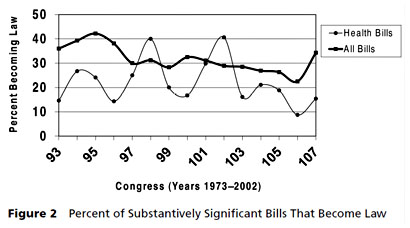Is Congress really more gridlocked than it used to be? Or is it just our imaginations? Don Taylor points us to a new paper by Craig Volden and Alan Wiseman that, among other things, codes every single one of the 119,040 bills introduced into the U.S. House of Representatives from 1973-2002 by type of bill. This is an impressive demonstration of either (a) massive  OCD or (b) massive maltreatment of grad students. I’m not sure which. But code them they have, and when they strip out all the trivial/symbolic/post office naming kinds of bills, they come to two conclusions:
OCD or (b) massive maltreatment of grad students. I’m not sure which. But code them they have, and when they strip out all the trivial/symbolic/post office naming kinds of bills, they come to two conclusions:
- There really has been a secular decline in the number of bills passed over the past couple of decades.
- Health bills have always had a harder time passing than other kinds of bills, so it’s hardly surprising that Obamacare was such a close run thing.
Taking a look at all bill types, it turns out that health bills were among the hardest to pass. What else is hard to pass? Social welfare, housing, labor, and civil liberties legislation. Liberals just have a tough time all around. More details at the link.















